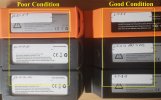- Joined
- Dec 10, 2021
- Messages
- 7
- Reaction score
- 1
- Age
- 61
I am hoping that the answers, corrections and verifications to the following questions for the Typhoon H plus OEM LiPo battery will not only help me but also those other newbies with similar questions. I use a RC charger rather the OEM charger (although I have read that the OEM charger does a good job at balancing the V for each cell).
Note: The OEM Battery specs are: 4S (4 cells), 5250 mA (5.25 A), 15.2 V (3.8V each cell) LiPo (Lithium Polymer) battery. No C rating is provided (Why?).
Note: The OEM Battery specs are: 4S (4 cells), 5250 mA (5.25 A), 15.2 V (3.8V each cell) LiPo (Lithium Polymer) battery. No C rating is provided (Why?).
- Voltage
- Maximum battery V is 16.8. Is this correct? This would equate to 4.2 V per cell. Any greater is a risk to the battery bursting into flames.
- Lowest battery cell V is 3.2V (drone back at home and off). Is this correct? Voltage lower than 3.2 risks reduction of the life span of the battery.
- Preferred storage battery cell V is 3.8V . Is this correct? When time to fly, balance charge the battery from 3.8V to 16.8 V. Is this correct? How long after the last flight should the battery be placed in the storage state?. Ie, amount of days since last flight.
- See Beginners Guide to LiPo Batteries for FPV Drones for more information.
- The same V for each cell is preferred. However, It is common for each cell (in my case ... 4 cells) to fluctuate in V. Thus the need for balance charging (I read elsewhere that the OEM charger balances the V quite well). What is considered the max range of V between cells before I need to be concerned? 0.4 V?
- Discharge (C) Rating
- Why did Kuneec choose to not provide the C rating on their OEM battery? For that matter, there isn't a C rating on a recently purchased 3rd party battery (GiFi Power). Nonetheless, I understand that most batteries these days have two C ratings. One for steady speed (continuous) and the other for acceleration (boost). The C rating number assigned to the battery is used to determine the maximum sustained load you can safely put on the battery from the drone motor for either condition. The formula is simply C x V. As an example, If a 4s, 5000mA (5 A), LiPo battery has a C rating of 10/15, then the continuous load would be 10 x 5.0 = 50.0 A. The boost load would be 15 x 5.0 = 75.0 A.
- My question is where are the specifications of a particular drone located so as to check against the C ratings of a particular battery? In the case of the Typhoon H Plus, I noted an ESC (Electronic Speed Control) spec of 25 A. How does this relate to the C-ratings, if any? I can't seem to find any other specs for the Typhoon H Plus that could be checked against the C ratings of a compatible battery. To complicate matters, and as stated previously, both the OEM and GiFi Power batteries don't specify any C ratings.
- From some research, I did note that in charging a battery, it is wise to charge at 1C. In other words, the 5.25 A battery shouldn't be charged at more than 1 x 5.25 A. Thoughts?
- See What is C Rating of LiPo Battery FPV Drones for more information.
- Internal Resistance.
- Each cell in a multi-cell battery has an internal resistance (IR) measured in Ohms (O). The recently purchased GiFi Power battery has the following IRs per the RC charger: 7.4, 14.9, 7.4 , and 14.9 mO. Total of 44.8 mO. My first question here is why the large range of IR between the cells? Is this normal? And are these values typical of a new battery?
- My OEM battery, which is bad, has one cell at 0.0 Ohms. Not sure if this adds up, but given V (Volt) = I (A) x IR (Ohm), the equation is bust if V, I, or R, is 0. It is a mathematical impossibility. As this was only one of the 4 cells, however, and the other 3 cells have an IR greater than 0, does it really matter given that the overall battery IR (summation of the IR of each individual cell) is greater than 0? Does disparity between each of the cells matter in this case?
- The battery weight of the OEM is 565 grams. The GiFi Power weighs 605 grams. Will this cause any concerns? The new battery is rated 7900mA, 15.2 V. I am not entirely sure that a 7.9 A battery would make up the difference for the heavier battery. Ie, motor strength increased? Is this associated with the ESC A?





